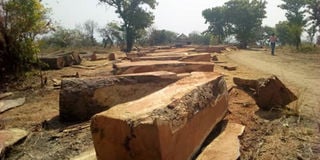West Nile turning into desert - CSOs

Deforestation. Some of the Afzelia Africana logs await sale in Okawa Village, Adjumani District. Several trees have been cut down for various purposes thus making land remain bare. COURTESY PHOTO
What you need to know:
- According to the Ministry of Energy and Mineral Development 2018 report, the primary source of energy in West Nile sub-region is firewood and fuel, accounting to 85 per cent.
Community over reliance on charcoal and firewood for cooking, besides illegal logging, is turning West Nile region into a desert, civil society organisations (CSOs) have warned.
The CSOs have revealed that many natural forests have been depleted for both domestic and commercial purposes, leaving most surfaces bare.
The chairman Northern Albertine Sustainable Energy Network, Mr William Amanzuru, at the weekend said it has become a norm for people to cut trees for various lucrative business.
“Everyday, trucks drive out of West Nile with logs, charcoal and firewood at will. We have become enemies of those who think that business is good for them and we are saboteurs when we talk,” he said.
According to the Ministry of Energy and Mineral Development 2018 report, the primary source of energy in West Nile sub-region is firewood and fuel, accounting to 85 per cent.
About 62 per cent of the households use electricity for lighting while solar lighting accounts for 81 per cent.
The Rural Initiative for Community Empowerment programme officer, Ms Comfort Yikiru, said their 2019 survey revealed that those engaged in charcoal business earn about Shs450,000 monthly while those in firewood business earn about Shs261,000.




